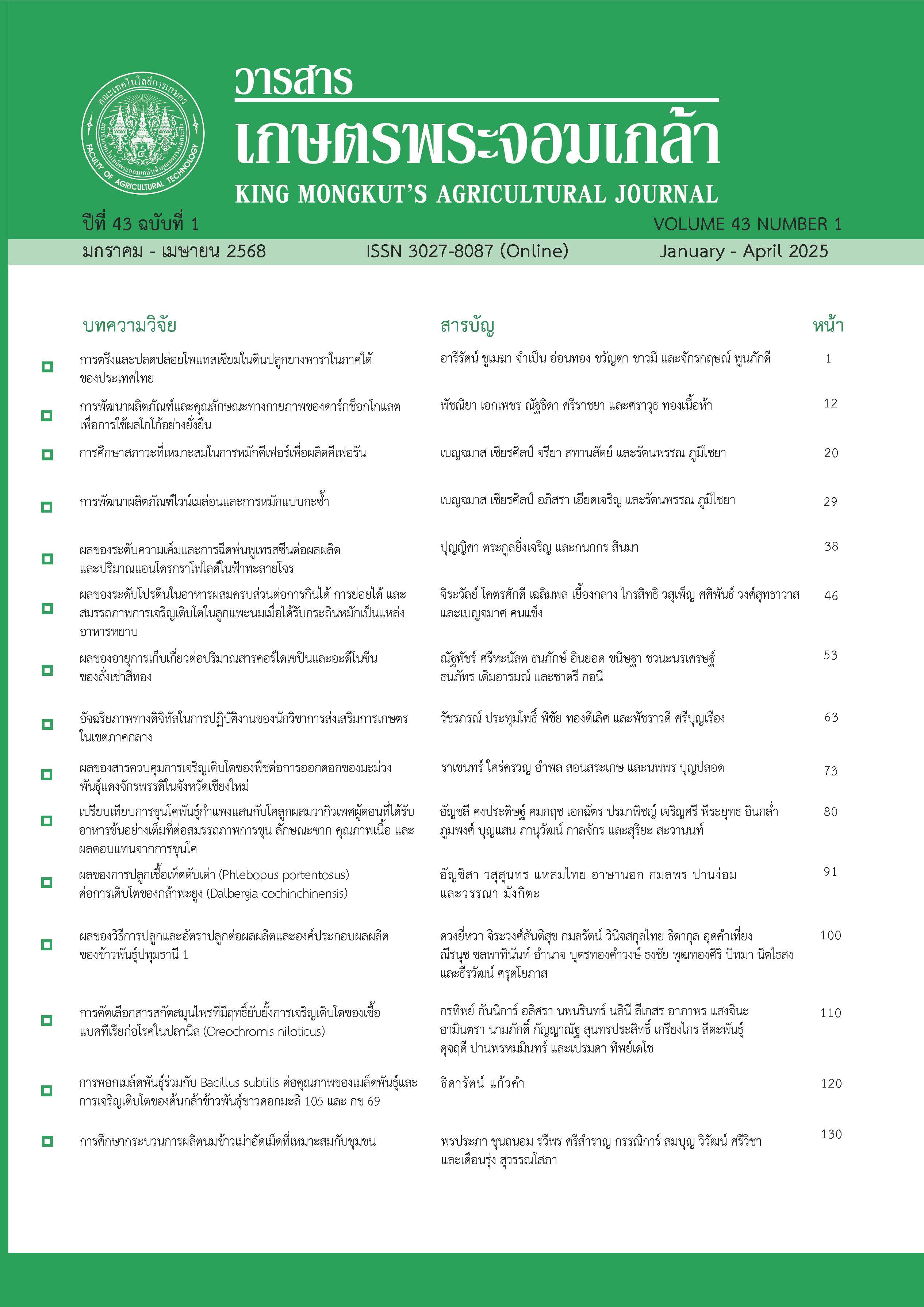Effects of Salt Level and Foliar Putrescine on Yield and Andrographolide Content of Andrographis paniculata
Main Article Content
Abstract
Salt stress is considered the most environmental factor for limiting yield and metabolite content of many plant species. Putrescine is an organic substance consisting of two amine groups. Putrescine plays an important role in many processes in plant growth and stress responds. This study investigated the effects of foliar application of putrescine (C4H12N2) on yield and andrographolide content of Andrographis paniculata under different salinity levels. The research was designed with completely randomized experimental plan (Factorial in CRD) replicating 5 times with 2 factors in Kamphaeng Saen soil experimental sample. Factor A indicated sanitary level which were at 0, 5, and 10 dS/m, and Factor B indicated putrescine concentration which were at 0, 150, and 300 ppm. Harvest was 120 days after planting. Dry and fresh weight of the shoots, H2O2, and andrographolide content were recorded. The results indicated that salinity level caused a significant decrease in fresh and dry weight of the shoot but there was an increase in H2O2 content. The application of Putrescine foliar significantly increased the weight and decreased H2O2 content compared to no Putrescine application. It was also found that the salinity caused the accumulation of andrographolide in Andrographis paniculata. The cumulative amount of andrographolide was significantly at the highest at 150 ppm of Putrescine at 80.7 and 307.1 mg/g, respectively.
Article Details

This work is licensed under a Creative Commons Attribution-NonCommercial-NoDerivatives 4.0 International License.
King Mongkut's Agricultural Journal
References
Elbar, O. A., Farag, R. E., & Shehata, S. A. (2019). Effect of putrescine application on some growth, biochemical and anatomical characteristics of Thymus vulgaris L. under drought stress. Annals of Agricultural Sciences, 64(2), 129-137. https://doi.org/10.1016/j.aoas.2019.10.001
Ben-Asher, J., Tsuyuki, I., Bravdo, B.-A., & Sagih, M. (2006). Irrigation of grapevines with saline water: I. Leaf area index, stomatal conductance, transpiration and photosynthesis. Agricultural Water Management, 83(1), 13-21. https://doi.org/10.1016/j.agwat.2006.01.002
Chuenim, N., Boonsuk, S., & Poopaibool, P. (2006). The determination of total lactone contents in andrographis herb from various locations. In Proceedings of the 44th Kasetsart University, pp. 534-538. Kasetsart University. (in Thai).
Ghalati, R. E., Shamili, M., & Homaei, A. (2020). Effect of putrescine on biochemical and physiological characteristics of guava (Psidium guajava L.) seedlings under salt stress. Scientia Horticulturae, 261(1), 108961. https://doi.org/10.1016/j.scienta.2019.108961
Department of Thai Traditional and Alternative Medicine. (2022). Precaution about Using “Andrographolide” in the Product "Fah Talai Joan" for "Treatment of COVID-19. Beyond Publishing Ltd. (in Thai).
Gill, S. S., & Tuteja, N. (2010). Polyamines and abiotic stress tolerance in plants. Plant Signaling Behavior, 5(1), 26-33. https://doi:10.4161/psb.5.1.10291
Islam, M. J., Ryu, B. R., Azad, M. O. K., Rahman, M. H., Rana, M. S., Lim, J. D., & Lim, Y. S. (2021). Exogenous putrescine enhances salt tolerance and ginsenosides content in Korean ginseng (Panax ginseng Meyer) sprouts. Plants, 10(7), 1313. https://doi.org/10.3390/plants10071313
Kumar, J., Singh, S., Singh, M., Srivastava, P. K., Mishra, R. K., Singh, V. P., & Prasad, S. M. (2017). Transcriptional regulation of salinity stress in plants: A short review. Plant Gene, 11(1), 160-169. https://doi.org/10.1016/j.plgene.2017.04.001
Ma, S., Zhou, X., Jahan, M. S., Guo, S., Tian, M., Zhou, R., & Shu, S. (2022). Putrescine regulates stomatal opening of cucumber leaves under salt stress via the H2O2-mediated signaling pathway. Plant Physiology and Biochemistry, 170(1), 87-97. https://doi.org/10.1016/j.plaphy.2021.11.028
National Drug System Development Committee. (2021). Thai Government Gazette 138. Retrieved from: http://dmsic.moph.go.th/index/download/852 (in Thai).
Osotsapa, Y. (2017). Plant stress and alleviate. Thai Journal of Soils and Fertilizers, 38(1), 47-78. (in Thai).
Pholphana, N., Rangkadilok, N., Saehun, J., Ritruechai, S., & Satayavivad, J. (2013). Changes in the contents of four active diterpenoids at different growth stages in Andrographis paniculata (Burm.f.) Nees (Chuanxinlian). Chin Med, 8(1), 2. https://doi:10.1186/1749-8546-8-2
Rajpar, I., Khanif Y. M., & Saad, M. S. (2007). Salt tolerance in Andrographis Paniculata accessions. Society for Southeast Asian Agricultural Sciences, 13(1), 1-9.
Rajpar, I., Yusop, M. K, Ul-hassan, Z., Shah, A. N. Arshad, M., & Galani, S. (2011). Growth, herb yield and phytochemical contents in a medicinal herb Andrographis paniculata under saline irrigation. Journal of Medicinal Plants Research, 5(23), 5528-33
Suleiman, S., Wilson, C., & Grieve, C. M. (2002). Effect of salinity and exogenously applied polyamines on growth and ion relations in spinach. Journal of Plant Nutrition, 25(12), 2705-2717. https://doi:10.1081/PLN-120015533
Talei, D., Valdiani, A., Maziah, M., Sagineedu, S. R., & Saad, M. S. (2013). Analysis of the anticancer phytochemicals in Andrographis paniculata Nees. under salinity stress. BioMed Research International, 2013(1), 319047. https://doi:10.1155/2013/319047
Tang, W., & Newton, R. J. (2005). Polyamines reduce salt-induced oxidative damage by increasing the activities of antioxidant enzymes and decreasing lipid peroxidation in Virginia Pine. Plant Growth Regulation, 46(1), 31-43. https://doi:10.1007/s10725-005-6395-0.
Tian, Y., Wang, Q., Zhang, L., Kang, G., Yang, L., Hao, H., & Cong, P. (2009). Promotion effect of exogenous putrescine on anthocyanin accumulation in ‘Red Fuji’. Apple Fruits, 44(03), 310-316. https://doi:10.3969/j.issn.1674-3466.2009.03.007
Velikova, V., Yordanov, I., & Edreva, A. (2000). Oxidative stress and some antioxidant systems in acid rain-treated bean plants: protective role of exogenous polyamines. Plant Science, 151(1), 59-66. https://doi.org/10.1016/S0168-9452(99)00197-1
Verma, S., & Mishra, S. N. (2005). Putrescine alleviation of growth in salt stressed Brassica juncea by inducing antioxidative defense system. Journal of Plant Physiology, 162(6), 669-677. https://doi.org/10.1016/j.jplph.2004.08.008
Wongkittipong, R., Prat, L., Damronglerd, S., & Gourdon, C. (2004). Solid–liquid extraction of andrographolide from plants—experimental study, kinetic reaction and model. Separation and Purification Technology, 40(2), 147-154. https://doi.org/10.1016/j.seppur.2004.02.002
Zapata, P. J., Serrano, M. a., Pretel, M. T., Amorós, A., & Botella, M. Á. (2004). Polyamines and ethylene changes during germination of different plant species under salinity. Plant Science, 167(4), 781-788. https://doi.org/10.1016/j.plantsci.2004.05.014


